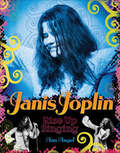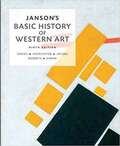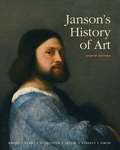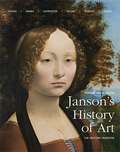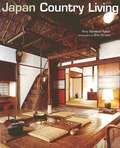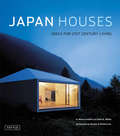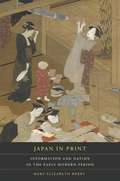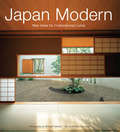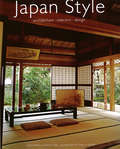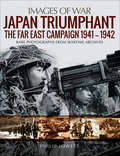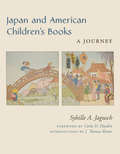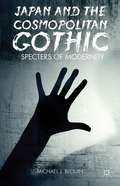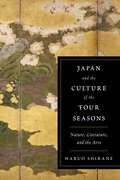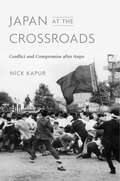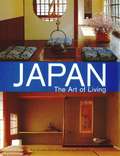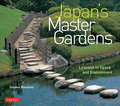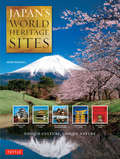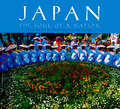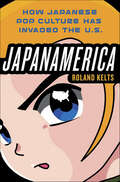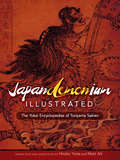- Table View
- List View
Janis Joplin: Rise Up Singing
by Ann AngelForty years after her death, Janis Joplin remains among the most compelling and influential figures in rock-and-roll history. Her story—told here with depth and sensitivity by author Ann Angel—is one of a girl who struggled against rules and limitations, yet worked diligently to improve as a singer. It’s the story of an outrageous rebel who wanted to be loved, and of a wild woman who wrote long, loving letters to her mom. And finally, it’s the story of one of the most iconic female musicians in American history, who died at twenty-seven. Janis Joplin includes more than sixty photographs, and an assortment of anecdotes from Janis’s friends and band mates. This thoroughly researched and well-illustrated biography is a must-have for all young artists, music lovers, and pop-culture enthusiasts.
Janson's Basic History Of Western Art
by Joseph Jacobs David Simon Ann Roberts Penelope Davies Frima HofrichterJanson’s Basic History of Art provides readers with a beautifully illustrated and masterfully concise introduction to the Western tradition of art history. The text centers discussions around the object, its manufacture, and its visual character. It considers the contribution of the artist as an important part of the analysis. <p><p> This edition creates a narrative of how art has changed over time in the cultures that Europe has claimed as its patrimony and that Americans have claimed through their connection to Europe. Janson’s Basic History of Western Art continues to maintain separate chapters on the Northern European Renaissance, the Italian Renaissance, and the High Renaissance, with stylistic divisions for key periods of the modern era. <p> The 9th edition brings some exciting changes. For the first time, Janson’s Basic History of Western Art comes with MyArtsLab, which provides students with an interactive learning experience. Also, the text incorporates new learning objectives, graphics, and maps throughout. In response to reviewer’s requests, this new edition expands the coverage of Islamic art into its own chapter.
Janson's History of Art: The Western Tradition
by Joseph Jacobs Penelope J. E. Davies Walter B. Denny Frima Fox Hofrichter Ann M. Roberts David L. SimonRewritten and reorganized, this new edition weaves together the most recent scholarship, the most current thinking in art history, and the most innovative online supplements, including digital art library. Experience the new Janson and re-experience the history of art. <p><p> Long established as the classic and seminal introduction to art of the Western world, the Eighth Edition of Janson's History of Art is groundbreaking. When Harry Abrams first published the History of Art in 1962, John F. Kennedy occupied the White House, and Andy Warhol was an emerging artist. Janson offered his readers a strong focus on Western art, an important consideration of technique and style, and a clear point of view. The History of Art, said Janson, was not just a stringing together of historically significant objects, but the writing of a story about their interconnections, a history of styles and of stylistic change. Janson’s text focused on the visual and technical characteristics of the objects he discussed, often in extraordinarily eloquent language. Janson’s History of Art helped to establish the canon of art history for many generations of scholars. <p> The new Eighth Edition, although revised to remain current with new discoveries and scholarship, continues to follow Janson’s lead in important ways: It is limited to the Western tradition, with a chapter on Islamic art and its relationship to Western art. It keeps the focus of the discussion on the object, its manufacture, and its visual character. It considers the contribution of the artist as an important part of the analysis. This edition maintains an organization along the lines established by Janson, with separate chapters on the Northern European Renaissance, the Italian Renaissance, the High Renaissance, and Baroque art, with stylistic divisions for key periods of the modern era. Also embedded in this edition is the narrative of how art has changed over time in the cultures that Europe has claimed as its patrimony.
Janson's History of Art: The Western Tradition
by Penelope J. E. Davies Frima Fox Hofrichter David L. Simon Joseph F. Jacobs Ann S. Roberts Family Trust JansonExplore the reissued Janson and experience the history of art <P><P> Janson’s History of Art: The Western Tradition, Reissued Eighth Edition presents the same content as the text’s Eighth Edition, published in 2010, now reimagined for digital learning via Revel, and also available through the Pearson Custom Library. While remaining current with new discoveries and scholarship, the Reissued Eighth Edition maintains its focus on the object, its manufacture, and its visual character, and continues to consider the contribution of the artist as a key element of analysis. Throughout, the authors engage students by weaving a compelling narrative of how art has changed over time in the cultures that Europe has claimed as its heritage.
Japan Country Living
by Amy Slyvester Katoh Shin KimuraFrom Japanese antiques to home and garden design, Japan Country Living is a delightful introduction for art and furniture lovers. In over 400 full-color photographs of quaint country homes, lush gardens, simple decorations and traditional dishes and recipes, the lifestyle of the Japanese countryside as it was yesterday can be found in this book. This book lets readers visit charming Japanese country homes and gardens and discover a lifestyle that has been handed down for centuries.
Japan Country Living
by Amy Slyvester Katoh Shin KimuraFrom Japanese antiques to home and garden design, Japan Country Living is a delightful introduction for art and furniture lovers. In over 400 full-color photographs of quaint country homes, lush gardens, simple decorations and traditional dishes and recipes, the lifestyle of the Japanese countryside as it was yesterday can be found in this book. This book lets readers visit charming Japanese country homes and gardens and discover a lifestyle that has been handed down for centuries.
Japan Home: Inspirational Design Ideas
by Noboru Murata Lisa Parramore Chadine Flood GongWhether you're remodeling your house, redesigning your apartment or just looking for a book of design ideas, Japan Home is a beautiful and indispensable resource full of practical information, shopping resources and inspiration.<P><P>Japanese interior design has long been renowned for its spare beauty, utility and grace. Today, more and more people outside Japan are incorporating Japanese features in their homes and gardens as they come to appreciate the way in which materials, colors, patterns and shapes are interwoven in a uniquely light and evocative way.Japan Home, lavishly illustrated with full-color photos and packed with practical information, is the perfect source for anyone eager to find ways to decorate or enhance their home with that special Japanese flair. The authors explore ways to create typical Japanese spaces both inside and outside the home that are tranquil yet dramatic, understated yet elegant. All designs are enriched with the distinct Japanese aesthetic.
Japan Houses: Ideas for the 21st Century
by Geeta K. Mehta Marcia Iwatate Takeshi NakasaThis Japanese architecture and design book is a wonderful source of new styles and ideas for those looking to add a distinctively Zen flair to their home.<P><P>Limited spaces, unlimited technology, a tradition of innovation, and sheer Japanese panache have combined to inspire the 26 stunning homes featured in Japan Houses. Conceived by 24 of Japan's leading architects and designers, each of the houses forecasts and defines a new trend in residential architecture, reinventing the meaning and use of space, material, and function.Traditional lifestyles are challenged, domestic functions such as cooking and entertaining are moved out of the house into the public domain, while laptops bring work back in. Zen minimalist is juxtaposed with comfortable opulence, time-honored workmanship is coupled with exciting new materials, resulting in a recognizable style that belongs to Japan, reflecting its culture and craftsmanship, while at the same time being avant-garde and international. The spirit of each of these astonishing houses is captured in beautiful photographs, plans and commentary.
Japan In Print: Information And Nation In The Early Modern Period (Asia: Local Studies / Global Themes Series #12)
by Anthony Grafton Mary Elizabeth BerryA quiet revolution in knowledge separated the early modern period in Japan from all previous time. After 1600, self-appointed investigators used the model of the land and cartographic surveys of the newly unified state to observe and order subjects such as agronomy, medicine, gastronomy, commerce, travel, and entertainment. They subsequently circulated their findings through a variety of commercially printed texts: maps, gazetteers, family encyclopedias, urban directories, travel guides, official personnel rosters, and instruction manuals for everything from farming to lovemaking. In this original and gracefully written book, Mary Elizabeth Berry considers the social processes that drove the information explosion of the 1600s. Inviting readers to examine the contours and meanings of this transformation, Berry provides a fascinating account of the conversion of the public from an object of state surveillance into a subject of self-knowledge. Japan in Print shows how, as investigators collected and disseminated richly diverse data, they came to presume in their audience a standard of cultural literacy that changed anonymous consumers into an “us” bound by common frames of reference. This shared space of knowledge made society visible to itself and in the process subverted notions of status hierarchy. Berry demonstrates that the new public texts projected a national collectivity characterized by universal access to markets, mobility, sociability, and self-fashioning.
Japan Journeys
by Andreas MarksPresenting classic Japanese woodblock prints,Japan Journeys offers a unique perspective on the country's most famous travel destinations. Art historian Andreas Marks has gathered together approximately two hundred Japanese woodblock prints depicting scenic spots and cultural icons that still delight visitors today. Many of the prints are by masters such as Utagawa Hiroshige, Kitagawa Utamaro, and Utagawa Kunisada, and currently hang in prestigious galleries and museums worldwide. Katsuhika Hokusai, the artform's most celebrated artist, is also well represented, with many prints from his "Fifty-three Stations of the Tokaido Road" series and "Thirty-six Views of Mount Fuji" series, including his world-renowned "Great Wave" print. In addition to prints showcasing Japan's natural beauty, Marks' carefully curated selection depicts roads and railways; favorite pastimes, such as blossom viewing and attending festivals; beloved entertainment, such as kabuki theater; the fashions they wore, and the food they ate. Marks is a leading expert on Japanese woodblock prints, and his Illuminating captions provide background context to the scenes depicted. Images of Japan are a continual source of fascination and delight for visitors and armchair travelers alike, and this original gift book also provides a valuable resource for art historians, scholars, and anyone interested in Japanese art, history, and traditional culture.
Japan Living: Form and Function at the Cutting Edge
by Geeta K. Mehta Marcia Iwatate Takeshi NakasaGain insight into both modern and Japanese styles with this stunning Japanese interior design book.Natural serenity, unostentatious refinement, clean lines and the balancing of light and space are all hallmarks of Japanese interior design. <P><P>In the new book from noted authors Marcia Iwatate and Geeta Mehta, Japan Living continues the themes of their highly successful Japan Houses with 30 specially designed houses that transcend function and resonate with spirit.The houses represented in Japan Living reflect the many changes in the dynamics of the new Japanese society, including an aging population and the desire to remain single; while others embody plenty of creativity, self-expression and individuality. Throughout, a return to traditional materials and design elements is married with such present-day requirements as minimalism, flexibility, a small kitchen, a beautiful bathroom, energy efficiency and electronic gadgetry. Each of these homes is an exquisite representation of the integrity consistently found within Japanese interior design, both in new construction and old.
Japan Modern: New Ideas for Contemporary Living
by Michael Freeman Michiko Rico NoseFeaturing over 200 stunning photographs, this Japanese design book captures the delightful, modern style of the Japanese home.Japan has always intrigued the world with its deceptively simple blending of architecture, landscape and design. <P><P>Zen temples, the famous tea ceremony, formal gardens, the use of wood, paper and other materials in the form of screens and floors--all have evolved over the years to create a varied, yet indisputably unique style. Japan Style showcases 40 contemporary homes, many never photographed before, and explores the unique Japanese design in all its manifestations. The book is divided into four chapters-- Reworking Tradition Managing Space Experimenting with Materials Personal Statements Each home is representative in its own way of the changing face of Japanese interior design and architecture and will be sure to inspire some new design ideas for your own home.
Japan Style
by Geeta K. Mehta Noboru Murata Kimie TadaEnter the world of the stylish Japanese house, where every object in sight is a work of art. Japan Style introduces 20 special residences. With more than 200 color photographs, this book showcases the stunning beauty of old homes, and reveals how they are cared for by their owners.Traditional Japanese homes, with superbly crafted fine wood, great workmanship and seasonal interior arrangements, have an aesthetic of infinite simplicity. Unlike Japanese inns and historical buildings, the houses featured in this book are private property and are not open to public viewing. Japan Style offers a rare glimpse into the intimate world of the everyday Japanese and fascinating insight into the traditional architecture of Japan.
Japan Triumphant: The Far East Campaign 1941-1942 (Images of War)
by Philip JowettImperial Japan&’s ambitious offensive at the beginning of WWII is captured in dramatic detail in this pictorial history featuring rare wartime photographs. The Japanese offensive in the Far East in 1941-1942 was extraordinary in its ambition, for their aim was to advance across the entire region. They clashed with an array of forces in a series of lightning campaigns that included famous episodes like the raid on Pearl Harbor and the conquest of Singapore. In this vivid photographic history, historian Philip Jowett covers the whole course of the offensive, portraying not only the Japanese military which achieved such incredible success but the armies they overwhelmed. In a sequence of over 200 wartime photographs—many of which have never been published before—Jowett covers the land, sea, and air fighting as the Japanese occupied so much of the region. Rare images of the Japanese forces as they prepared for war and then made seemingly unstoppable progress are matched with images of the armies they surprised and vanquished. Japan Triumphant captures the character of the war in the Far East, showing the appearance, equipment, and weaponry of the armies involved as well as the conditions in which they fought.
Japan and American Children's Books: A Journey
by Sybille JaguschFor generations, children’s books provided American readers with their first impressions of Japan. Seemingly authoritative, and full of fascinating details about daily life in a distant land, these publications often presented a mixture of facts, stereotypes, and complete fabrications. This volume takes readers on a journey through nearly 200 years of American children’s books depicting Japanese culture, starting with the illustrated journal of a boy who accompanied Commodore Matthew Perry on his historic voyage in the 1850s. Along the way, it traces the important role that representations of Japan played in the evolution of children’s literature, including the early works of Edward Stratemeyer, who went on to create such iconic characters as Nancy Drew. It also considers how American children’s books about Japan have gradually become more realistic with more Japanese-American authors entering the field, and with texts grappling with such serious subjects as internment camps and the bombing of Hiroshima and Nagasaki. Drawing from the Library of Congress’s massive collection, Sybille A. Jagusch presents long passages from many different types of Japanese-themed children’s books and periodicals—including travelogues, histories, rare picture books, folktale collections, and boys’ adventure stories—to give readers a fascinating look at these striking texts. Published by Rutgers University Press, in association with the Library of Congress.
Japan and the Cosmopolitan Gothic
by Michael J. BlouinJapan is imagined routinely in American discourse as a supernatural entity. Gothic tales from these two cultures have been exchanged, consumed, and adapted. Here, Blouin examines a prevalent tendency within the United States-Japan cultural relationship to project anxiety outward only to find shadowy outlines of the self abroad.
Japan and the Culture of the Four Seasons: Nature, Literature, and the Arts
by Haruo ShiraneElegant representations of nature and the four seasons populate a wide range of Japanese genres and media—from poetry and screen painting to tea ceremonies, flower arrangements, and annual observances. In Japan and the Culture of the Four Seasons, Haruo Shirane shows how, when, and why this practice developed and explicates the richly encoded social, religious, and political meanings of this imagery. Refuting the belief that this tradition reflects Japan's agrarian origins and supposedly mild climate, Shirane traces the establishment of seasonal topics to the poetry composed by the urban nobility in the eighth century. After becoming highly codified and influencing visual arts in the tenth and eleventh centuries, the seasonal topics and their cultural associations evolved and spread to other genres, eventually settling in the popular culture of the early modern period. Contrasted with the elegant images of nature derived from court poetry was the agrarian view of nature based on rural life. The two landscapes began to intersect in the medieval period, creating a complex, layered web of competing associations. Shirane discusses a wide array of representations of nature and the four seasons in many genres, originating in both the urban and rural perspective: textual (poetry, chronicles, tales), cultivated (gardens, flower arrangement), material (kimonos, screens), performative (noh, festivals), and gastronomic (tea ceremony, food rituals). He reveals how this kind of "secondary nature," which flourished in Japan's urban architecture and gardens, fostered and idealized a sense of harmony with the natural world just at the moment it was disappearing. Illuminating the deeper meaning behind Japanese aesthetics and artifacts, Shirane clarifies the use of natural images and seasonal topics and the changes in their cultural associations and function across history, genre, and community over more than a millennium. In this fascinating book, the four seasons are revealed to be as much a cultural construction as a reflection of the physical world.
Japan at the Crossroads: Conflict and Compromise after Anpo
by Nick KapurIn 1960, when Japan revised the postwar treaty that allows a U.S. military presence in Japan, the popular backlash changed the evolution of Japan’s politics and culture, and its global role. Nick Kapur’s analysis helps resolve Japan’s essential paradox as being innovative yet regressive, flexible yet resistant, imaginative yet wedded to tradition.
Japan the Art of Living
by Amy Slyvester Katoh Shin KimuraIn more than 300 beautiful photographs of the homes of both Westerners and Japanese, this book presents the art of living with Japanese style, offering exciting new ideas and inspiration for all. Exquisite homes in the Tokyo area, focusing on original and attractive use of Japanese antiques and folk crafts, are showcased. Also included is the latest information on antique markets and hints for where to see the art of living - in galleries, textile and craft shops, and resaurants.
Japan the Art of Living
by Amy Slyvester Katoh Shin KimuraIn more than 300 beautiful photographs of the homes of both Westerners and Japanese, this book presents the art of living with Japanese style, offering exciting new ideas and inspiration for all. Exquisite homes in the Tokyo area, focusing on original and attractive use of Japanese antiques and folk crafts, are showcased. Also included is the latest information on antique markets and hints for where to see the art of living - in galleries, textile and craft shops, and resaurants.
Japan's Master Gardens
by Stephen MansfieldNo two Japanese gardens are ever the same. Each is inimitable, yet embodies commonalities of design and aesthetic taste. Each finds the space for innovation within a tradition that benefits from a thousand years of applied knowledge. Presenting twenty-five master gardens, Japan's Master Gardens explores the ingenuity and range of Japanese landscaping, from the self-imposed confines of courtyard designs to the open expanses of the stroll garden.Japan's Master Gardens illustrates how, through the ministrations of generations of gardeners, original landscapes have maintained their mastery and demonstrates how contemporary landscaping draws from tradition, making ancient gardens relevant to the lives of people in the twenty-first century.This beautifully illustrated book takes readers on an exploration of the outward forms, underpinning principles, complex use of metaphor and allusion, and beauty and depth that set the Japanese garden apart.
Japan's World Heritage Sites
by John DougillVisit the most compelling cultural and nature sites in all of Japan!In Japan's World Heritage Sites, readers are introduced to the temples, gardens, castles and natural wonders for which Japan is so justly renowned-all of those now declared to be UNESCO World Heritage Sites. Author John Dougill describes each site in detail, stating why they were singled out by UNESCO, the current number and types of sites, the application process, how the sites have been selected, and how difficult it is to be given the special status of a World Heritage Site.Dougill traveled to all of the sites in Japan to research this book. These are without a doubt the most interesting sites that Japan has to offer, including: Mount Fuji, Japan's tallest and most sacred volcano. Himeji Castle, a monument from Japan's long feudal history. Horyu-ji Temple, the world's oldest surviving wooden structure Hiroshima Peace Memorial or Atomic-Bomb Dome The Ogasawara Islands, a remote archipelago of over 30 islands-including Iwo JimaReaders will learn how Japan first became involved with the World Heritage Sites program back in 1993, the importance of these designations, and their popularity in Japan, where they are visited by millions of people annually.
Japan: The Soul of a Nation
by John Carroll Michael YamashitaFeaturing over 140 stunning photographs, this Japan travel pictorial captures all the beauty and high culture of Japan.Japan has fascinated foreign visitors and observers for centuries. <P><P>Although Columbus did not find fables Zipang and its troves of gold he sought, countless sojourners in Japan - ranging from 16th century missionaries to 20th century backpackers with a yen for Zen - have had eye opening encounters with this land of contrasts. Physically one of the most beautiful countries in the world, and a civilization in its own right, Japan remains something of an enigma to outsiders. Futuristic visions seem to bloom effortlessly from time-honored traditions.This compelling photographic study by one of the world's leading photographers will take you from country roads to the skyscrapers of its amoebae-like megacities, from meditation-inducing rock gardens to the other-worldly frenzy of communal festivals. Through initiation into their psychology, mores, and religious and artistic sentiments, you'll learn something of what it means to be Japanese
Japanamerica: How Japanese Pop Culture Has Invaded the U.S.
by Roland KeltsContemporary Japanese pop culture such as anime and manga (Japanese animation and comic books) is Asia's equivalent of the Harry Potter phenomenon--an overseas export that has taken America by storm. While Hollywood struggles to fill seats, Japanese anime releases are increasingly outpacing American movies in number and, more importantly, in the devotion they inspire in their fans. But just as Harry Potter is both "universal" and very English, anime is also deeply Japanese, making its popularity in the United States totally unexpected. Japanamerica is the first book that directly addresses the American experience with the Japanese pop phenomenon, covering everything from Hayao Miyazaki's epics, the burgeoning world of hentai, or violent pornographic anime, and Puffy Amiyumi, whose exploits are broadcast daily on the Cartoon Network, to literary novelist Haruki Murakami, and more. With insights from the artists, critics, readers and fans from both nations, this book is as literate as it is hip, highlighting the shared conflicts as American and Japanese pop cultures dramatically collide in the here and now.
Japandemonium Illustrated: The Yokai Encyclopedias of Toriyama Sekien
by Toriyama SekienFirst English publication of all four of Sekien's masterworks: The Illustrated Demons' Night Parade, More Illustrated Demons from Past and Present, Even More Demons from Past and Present, and An Idle Horde of Things.
